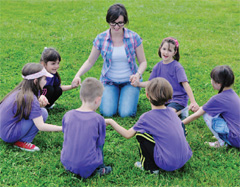Exploring Classroom Size
Can Fewer Students Improve Your Child's Learning?
by Susan Flowers

The role of class size in student success has been a source of debate
among educators for years. And in the wake of a 2010 Georgia Board of Education decision lifting limits on class sizes, it continues to be a topic of discussion for teachers and administrators.The debate has been raging since at least the 1980s, when Tennessee launched Project STAR (Student-Teacher Achievement Ratio), a large-scale study of the effects of reduced class size on children from kindergarten through third grade. The study concluded that smaller classes of around 15 children resulted in “substantial improvement” in student learning.
At many of Atlanta’s independent schools, small classes are seen as drivers of achievement. This is in part because smaller classes allow teachers to genuinely understand and connect with their students, says Diane Stinger, assistant principal at the Atlanta Academy.
“When there are fewer kids in the class, the teacher has the opportunity to really get to know the kids,” she says. “They know the students and the families and their pets and everything. It’s a great learning environment.”
 Classes at Atlanta Academy average around 13 students, and Stinger says this size is ideal for the school’s workshop-style lessons, allowing students to learn independently.
Classes at Atlanta Academy average around 13 students, and Stinger says this size is ideal for the school’s workshop-style lessons, allowing students to learn independently.Deborah Marshall, director of institutional advancement at Brandon Hall, agrees that a less-crowded classroom leads to better outcomes for young learners.
“It allows the teacher to spend one-on-one time with the student, to help them with lessons and problems they’re having with that lesson,” she says, noting that teachers are able to give “more time to the student.
Brandon Hall’s student/teacher ratio of three to one, with classes ranging from as few as one student to a maximum of eight, also fosters an atmosphere that encourages participation, says Marshall. “If there’s a student who’s on the quiet side, that student has more of a chance to speak out,” she says. “The kids have to be prepared because they will be participating. [In a large class] if you didn’t want to raise your hand and be called on, you didn’t have to. There’s accountability, and that’s a life lesson, too.”
Customized Learning
At the Galloway School, small classes are the rule at every level, from 3-year-olds to 12th-graders. Admissions Director Polly Williams says that having fewer students allows for a more customized learning style.
“We can’t individualize the curriculum, but we can personalize it to some extent,” she says. “If a student needs a more accelerated program in a particular subject or they are very interested in a particular topic, then we can develop that for them.”
Maximizing teacher attention is a definite benefit for students with special needs. At the Bedford School, which focuses on learning disabilities for children in grades one through nine, classes have no more than 12 students, with an overall student/teacher ratio of eight to one.
 “We use small classes because our students need the individualized attention,” says founder and director Betsy Box, adding that smaller class sizes cut down on distractibility and discipline issues.
“We use small classes because our students need the individualized attention,” says founder and director Betsy Box, adding that smaller class sizes cut down on distractibility and discipline issues.“It helps the teacher because she can teach and not just manage the class,” she says. “In a small class, children are more willing to volunteer or take a risk. They’re not as worried about getting laughed at. In a small class, they feel more confident and are more willing to risk being wrong.”
Approaching the issue from a different angle is Montessori. The Montessori philosophy calls for grouping students of varying ages according to their windows of development. Montessori deliberately fosters larger classes of around 25-30 students, with 25 considered the target number.
But a focus solely on the system’s class size is misleading, says Ernestine Morgan, admissions coordinator at First Montessori School of Atlanta. Throughout the Montessori experience, student/teacher ratios are kept low, with one teacher for every three to six students, and students receive a great deal of one-on-one attention at every turn.
“Our philosophy is built upon following the child and delivering the lesson in ways that are meaningful to each child and would meet academic needs,” she says.
Infinity and Beyond
Since the Georgia Board of Education voted to remove limits on class sizes due to a budget crisis brought on by the struggling economy, “there really aren’t [mandated] class sizes anymore,” says Thomas Van Soelen, associate superintendent for City Schools of Decatur. “Each school gets to decide.”
Van Soelen cautions that concentrating too much on classroom size instead of other factors misses the bigger picture.
But he’s quick to point out that City Schools of Decatur, which operates nine charter schools, works to keep its classes smaller than the law previously mandated.
“Our charter actually says that our class size can go to the state maximum, and then add two,” he says of the system. “So technically, our class size is infinity. And since we can go plus two it’s sort of like Buzz Lightyear: infinity and beyond. But that doesn’t mean we’re there.”
The system’s average first-grade class is 21 students, below the previous state maximum of 23. The average fourth-grade class has 25 students, and the sixth-grade average is 21, below the previous limit of 28 for grades four to eight.
In high school, sizes are broken down more by content than by grade level: the system’s social studies classes, for example, average around 25 students.
At Marietta City Schools, the average elementary classroom contains 20 students, while the average secondary school class contains 25, according to Director of Communications Thomas Algarin.
Ultimately, Van Soelen says, the number of students in the class isn’t as important as who’s leading that class.
“We believe it’s important to point out that teacher quality is more important than class size,” he says, adding that City Schools of Decatur focuses its priorities more on improving the skills of its educators than on reducing the number of students in a given class.
“It’s the teacher,” he says, “that makes the difference.”
KNOW YOUR TERMS
School literature on class size may contain some confusing terminology.
Be aware of these common terms.
WHAT IS A SMALL CLASS?
Research has shown that classes of less than 20 students can greatly affect student achievement.
WHAT IS AVERAGE CLASS SIZE?
This is the number of students in classes divided by the number of classes.
WHAT IS TEACHER-STUDENT RATIO?
This comes from dividing the number of a school’s teachers by the total number of students. A school’s teacher-student ratio is not the same as its average class size.







